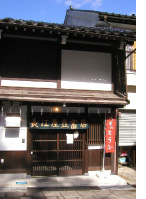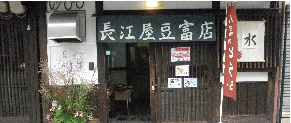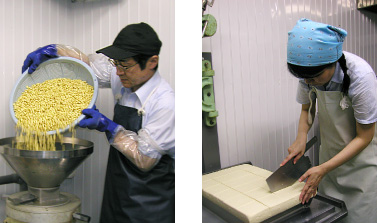Introduction to Shop
Nagaeya-Tofuten locates in the Yatsuo Town, Toyama city, Toyama prefecture. A small town in a gorge. The town is crowded for the Hikiyama festival in May in balmy breeze blowing. It is spectacular to see the six two-story hikiyama cars go slowly and solemnly drawn by town people using two lopes up and down the slopes. They are decorated with gorgeous wood engravings and glittering metal carvings. It is as if we see one scene of a movie. In the first three days of September with the wind of “two hundred and ten days” from the beginning of spring blowing, the town becomes seductive by “Owara Kaze-no-Bon”. An elegant and wonderful dancing is unfolded here and there in the town with unique singers and instruments. Especially the town marching in the midnight is as a dream with a subtle and profound atmosphere. Though it is a small town, it prospered in the Edo era supporting the finance of the Toyama clan by its products of sericulture and washi, the Japanese paper. Also it flourished as a relay point of the trade in the main road from the Toyama Gulf to Hida-Takayama with ocean and mountain blessings..

The people of Yatsuo, who made an affluent economy by its specialty products and trade, raised a high quality merchant culture, which became as the Owara and hikiyama that have come down unbrokenly. Nagaeya-Tofuten opened on February 3rd in 2007 in the Suwamachi Street which retains the vestiges of the old time in the Yatsuo town. The shop location is the opposite of the Suwa shrine, the name of which Suwamachi originates. The street is aesthetic with the view of snow shoveling and others became one of the hundred Japanese selected streets.
 Structure
Structure
 At an instant you turn the corner of a street, the scenery will take you back in time. And, it appears the Suwamachi Street as if its townscape is like in the Edo era. Both sides of the street along a gentle slope are the houses of wooden grilles stand side by side. The structure of Nagaeya-Tofuten is about one hundred and thirty years old with two kens* in the front and twelve kens long. The narrow and long structure is said as “eel’s bed”. The house was built in 1882, Meiji 15, one year earlier than the “Rokumeikan” built. Only the base story of the two-story house was reformed for the selling space, workshop and warehouse. The façade is consisted of mortarplasterstucco wall and wooden lattice door and window. Because the appearance is a stereotype townhouse, it merges into the streetscape. Since it is so small, you will overlook the shop unless the shop blue curtain and/or the red banner is set out. It is said to be the second oldest house in the Suwamachi Street as it did not burn in the big fire in 1897.
At an instant you turn the corner of a street, the scenery will take you back in time. And, it appears the Suwamachi Street as if its townscape is like in the Edo era. Both sides of the street along a gentle slope are the houses of wooden grilles stand side by side. The structure of Nagaeya-Tofuten is about one hundred and thirty years old with two kens* in the front and twelve kens long. The narrow and long structure is said as “eel’s bed”. The house was built in 1882, Meiji 15, one year earlier than the “Rokumeikan” built. Only the base story of the two-story house was reformed for the selling space, workshop and warehouse. The façade is consisted of mortarplasterstucco wall and wooden lattice door and window. Because the appearance is a stereotype townhouse, it merges into the streetscape. Since it is so small, you will overlook the shop unless the shop blue curtain and/or the red banner is set out. It is said to be the second oldest house in the Suwamachi Street as it did not burn in the big fire in 1897.
*One ken is 180 centimeters.
 Shop name
Shop name
 In the middle of Edo era it was an ancestor Gonjiro san who went back and forth from Toyama to Hida-Takayama along the Buri* road carrying various goods for trade.
In the middle of Edo era it was an ancestor Gonjiro san who went back and forth from Toyama to Hida-Takayama along the Buri* road carrying various goods for trade.
 How many times did he haunt the steep mountain road? A descendant settled a store in Toyama city in the end of Edo era and named it “Nagaeya Store”. Now we started the tofu shop as “Nagaeya-Tofuten”. We changed the Chinese character of the “fu” in tofu from the original one to the one as in the Toyama’s “Tomi”, the meaning of which is wealth.
How many times did he haunt the steep mountain road? A descendant settled a store in Toyama city in the end of Edo era and named it “Nagaeya Store”. Now we started the tofu shop as “Nagaeya-Tofuten”. We changed the Chinese character of the “fu” in tofu from the original one to the one as in the Toyama’s “Tomi”, the meaning of which is wealth.
*Buri is Yellowtail fish.
Only two persons work at the shop, the master and his wife to make and sell tofu.
The tofu is of good taste without putting anything. The tofu to want more. Never be bored to eat even when you do everyday. Smile when you eat. They make efforts to make such tofu to be worthy to the name “ Yatsuo no Tofu” that means the tofu of Yatsuo. The name was given by an esteemed Mr. Keisuke Yoshida.
*Mr. Yoshida dedicated to not only the inheritance and development of the Japanese paper, washi, of Yatsuo, but also to the washi culture of Japan and Mingei, people’s hand crafts to prevail and develop. He established Keijusha to make washi products and Washi-Bunko, a paper museum as well as he himself designed Kata-e-zome, a stencil dye.




